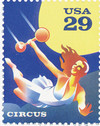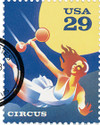
1993 29c Circus: Trapeze Artist
# 2752 - 1993 29c Circus: Trapeze Artist
$0.50 - $3.20
US #2752
29¢ Trapeze Artist
Circus
29¢ Trapeze Artist
Circus
- Issued to commemorate the 200th anniversary of the first circus in America
Stamp Category: Commemorative
Value: Each stamp is valued at 29¢
First Day of Issue: April 6, 1993
First Day City(s): Washington, DC
Quantity Issued: 65,625,000
Printed by: Ashton-Potter (USA)
Printing Method: Offset
Format: Plates of 240 separated into panes of 40
Perforations: 11
Value: Each stamp is valued at 29¢
First Day of Issue: April 6, 1993
First Day City(s): Washington, DC
Quantity Issued: 65,625,000
Printed by: Ashton-Potter (USA)
Printing Method: Offset
Format: Plates of 240 separated into panes of 40
Perforations: 11
Why the stamp was issued: This stamp is part of a block of four issued in honor of the 200th anniversary of the first circus in the US. It took place on April 3, 1793 in Philadelphia.
About the stamp design: The stamps in this block are semi-jumbo size. The designs show the work of painter Steve McCracken. He created images that reflect art found on posters. The portion of a yellow oval found on each stamp represents a spotlight.
Special design details: To prevent counterfeiting, “1992” was microprinted on each stamp. With a magnifying glass, it can be found on the bottom of the trapeze bar in red lettering.
First Day City: Washington, DC was the First Day city. The Ringling Brothers and Barnum & Bailey Circus opened there that evening. King Tusk, one of the circus’s elephants, participated in the ceremony by cancelling a giant replica of the stamp with a specially-made rubber stamp.
History the stamp represents: During the 18th century, circuses in Europe often focused on horseback riding stunts. Soon clowns and acrobats were added. On April 3, 1793, a Scottish horseman, John Bill Ricketts brought the circus to America. He set up a ring in a building in Philadelphia, the nation’s capital at the time. In addition to showing his horsemanship, Ricketts also had a clown, an acrobat, and a ropewalker. One of the residents who came to see the circus was President George Washington. Ricketts’ circus was successful, and he went on tour the following year.
US #2752
29¢ Trapeze Artist
Circus
29¢ Trapeze Artist
Circus
- Issued to commemorate the 200th anniversary of the first circus in America
Stamp Category: Commemorative
Value: Each stamp is valued at 29¢
First Day of Issue: April 6, 1993
First Day City(s): Washington, DC
Quantity Issued: 65,625,000
Printed by: Ashton-Potter (USA)
Printing Method: Offset
Format: Plates of 240 separated into panes of 40
Perforations: 11
Value: Each stamp is valued at 29¢
First Day of Issue: April 6, 1993
First Day City(s): Washington, DC
Quantity Issued: 65,625,000
Printed by: Ashton-Potter (USA)
Printing Method: Offset
Format: Plates of 240 separated into panes of 40
Perforations: 11
Why the stamp was issued: This stamp is part of a block of four issued in honor of the 200th anniversary of the first circus in the US. It took place on April 3, 1793 in Philadelphia.
About the stamp design: The stamps in this block are semi-jumbo size. The designs show the work of painter Steve McCracken. He created images that reflect art found on posters. The portion of a yellow oval found on each stamp represents a spotlight.
Special design details: To prevent counterfeiting, “1992” was microprinted on each stamp. With a magnifying glass, it can be found on the bottom of the trapeze bar in red lettering.
First Day City: Washington, DC was the First Day city. The Ringling Brothers and Barnum & Bailey Circus opened there that evening. King Tusk, one of the circus’s elephants, participated in the ceremony by cancelling a giant replica of the stamp with a specially-made rubber stamp.
History the stamp represents: During the 18th century, circuses in Europe often focused on horseback riding stunts. Soon clowns and acrobats were added. On April 3, 1793, a Scottish horseman, John Bill Ricketts brought the circus to America. He set up a ring in a building in Philadelphia, the nation’s capital at the time. In addition to showing his horsemanship, Ricketts also had a clown, an acrobat, and a ropewalker. One of the residents who came to see the circus was President George Washington. Ricketts’ circus was successful, and he went on tour the following year.













